
Landa consigning books to the flames
*
Español
January 28, 2024
by Philip Gambone
Back in September, I went to Berlin, a trip I undertook to join my brother in cheering on his wife and daughter, both of whom were running in the Berlin Marathon. After the race, all of us spent a few more days in the city. It was my family's first trip to the German capital, but as I had been there on several previous occasions, we decided to go our separate ways during the day, they to explore some of the must-do sights, and I to visit museums I'd not been to on previous occasions.
One afternoon, I took myself to the Humboldt Forum Museum, housed in the reconstructed Prussian Palace in the former East Berlin. The museum, considered the German equivalent to the British Museum, houses the non-European collections of the Berlin State Museums. My particular aim was to see their superb collection of pre-Columbian artifacts, mainly pottery and sculpture. In total, the Museum holds about 50,000 objects from ancient Mesoamerica, of which only a small percentage is exhibited at any one time.

Humboldt Forum Museum, Berlin
*
The collection—which includes pieces from Aztec, Huastec, Zapotec, Chichimeca, and other Indigenous, pre-conquest Mexican cultures—was amazing. I spent a lot of time looking at the displays, reading the descriptions, and snapping lots of photos of these superb antiquities. But a surprise awaited me. The collection includes a plethora of artifacts—mainly stone tablets and pictorial manuscripts—that document ancient Mesoamerican writing systems or, as the museum prefers to call them, "graphical communication systems." As someone who is interested in "The Writer in Mexico," these examples of pre-conquest texts bowled me over. They were stunning visual reminders of something I already knew but had failed to adequately appreciate: writing in Mexico didn't begin with the arrival of the Spaniards; it has a much longer history.
Fray Toribio de Benavente ("El Fraile de los Aztecas"), one of the original twelve Franciscans who came to Nueva España in 1524, was one of the first to notice how the Nahua—the Indigenous peoples of the high Mexican plateau—kept written records using a pictorial system, which he compared to Egyptian hieroglyphics. In fact, there were at least fifteen different writing systems that were employed in pre-Columbian Mesoamerica, the oldest dating from around 900 to 600 BCE, about the time that Homer was composing the Iliad and the Odyssey.
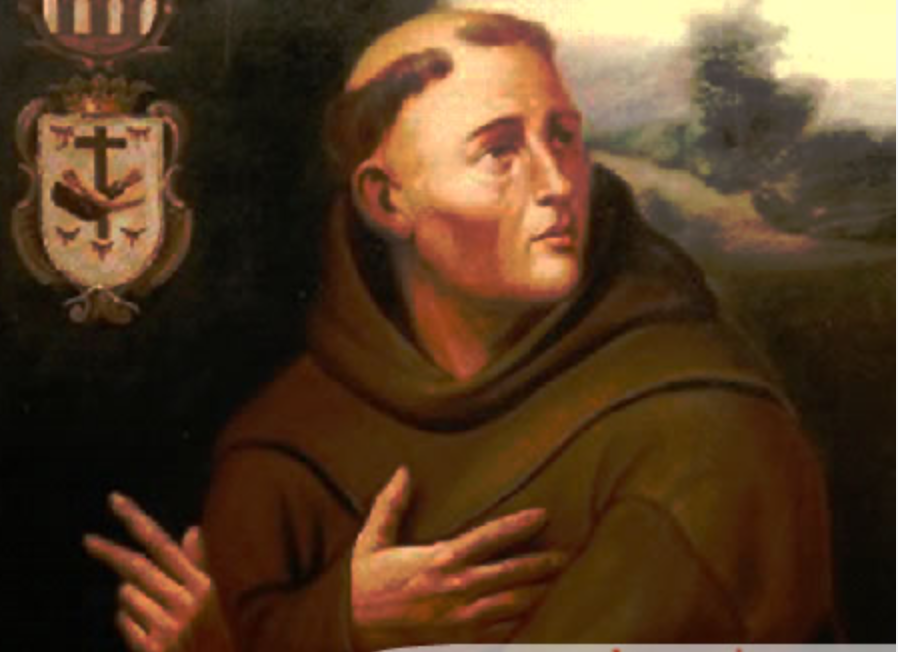
Fray Toribio de Benevente
*
Communication systems based on mutually understandable pictures were developed. These pictures could be employed across regions where different languages were spoken, and thus interpreted in the respective languages. (A rough equivalent would be modern Chinese, which uses characters that are pronounced one way in Mandarin and another way in Cantonese.)
For the most part, the Aztecs recorded language using a pictographic system. The system served as a kind of memory-jogging device. Pictures not only stood for recognizable objects—sun, buildings, warriors—but could also designate dates, place names, and abstract concepts. A tongue, for example, was used to denote speaking; a foot-print for travelling; a wrapped mummy figure for death. By combining these pictorial elements to express complicated meanings, the Aztecs were able to produce "a staggering amount of records," to quote from another scholar of Mesoamerican culture, Victor W. von Hagen.
Below are a couple of photos I took at the museum of the extant right half of a Zapotec stone plaque (ca. 800-950 CE). The person on the right is talking to someone facing him, indicated by a speech scroll emanating from his mouth.
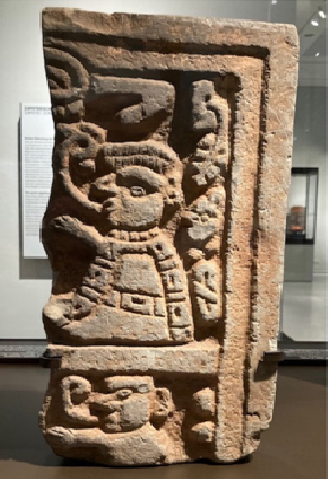
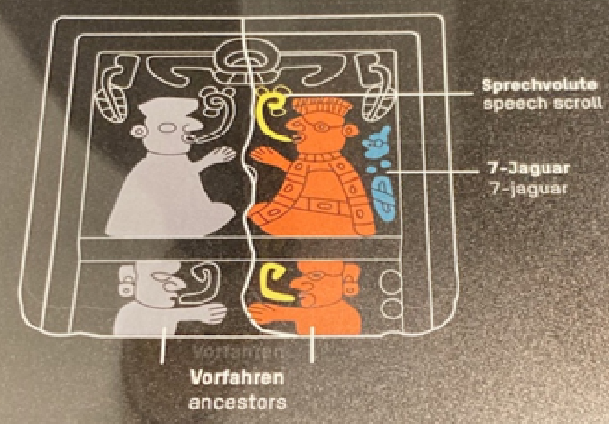
William H. Prescott, whose The History of the Conquest of Mexico (1843) is a classic, wrote: "In casting the eye over a Mexican manuscript, one is struck with the grotesque caricatures it exhibits of the human figure; monstrous, overgrown heads on puny, misshapen bodies. On closer inspection, however, it is obvious that it is not so much a rude attempt to delineate nature, as a conventional symbol, to express the idea in the most clear and forcible manner." Prescott drew an analogy to chess pieces which "bear little resemblance, usually, to the objects they represent."
The painter-scribes were wise men who, according to another Franciscan, possessed "a heart made divine." As one Aztec poem put it:
The good painter, understanding
God in his heart,
Defines things with his heart,
Dialogues with his own heart.
Called "artists of black and red ink," the painter-scribes created "books" known as codices in today's scholarly community. The codices were written on long folded sheets made of several kinds of material: cloth, prepared skins, or a kind of paper made from agave or maguey. These sheets, to quote from Diego de Landa, who was one of the first Spaniards to note the presence of Nahua books, were then "pleated to enclose it all between two boards which made them handsome, on which they wrote from one end to the other, in columns aligned with the folds." Bernal Diaz recorded seeing "many paper books doubled together in folds like Spanish cloth."
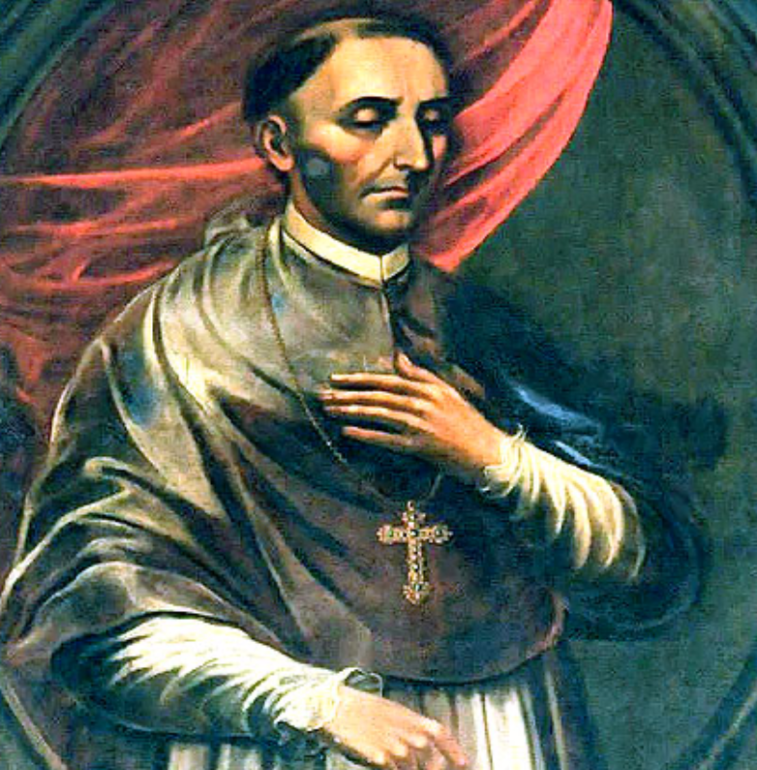
Diego de Landa
*
The Nahua considered those who knew how to "open the books' pages" the wise men (tlamatini) of the community. Reading one of these books involved, as Miguel León-Portilla, an eminent scholar of ancient Mexican writing systems, puts it, "following 'the path of the codex,' i.e., its graphic and glyphic sequences, with one's eye."
While "reading" was, for the most part, the prerogative of the educated elite, all Nahuatl boys attended some sort of school, either the calmecac, where intellectual development was stressed; or a telpochcalli, which placed emphasis on becoming a warrior. In either case, the boys, we learn from one of the codices, "were taught to speak well and … were taught all the verses of songs, which were called divine songs, and which were written in their books with characters."
The stories and other information inscribed in the codices were deemed "a bequest to those of us who are now living," as one Nahua text says. "It will never be lost, it will never be forgotten, what they came to do, what they recorded in their paintings, their renown, their history, their memory." Future generations were admonished to respect their ancestors: "Do not sully, do not defile their black and red ink."
Among the information the codices contained were stories of the origins of the cosmos, the universe of the gods, the creation of human beings, the interaction between men and gods, the discovery of corn, and the history of the particular people who created the codex. Other books recorded dreams, songs, lineage documents, land ledgers, herbal remedies, and "maps" for anyone undertaking a long journey. Still other books kept record of different objects—corn, cacao, animal skins, birds—and tell us of the greatness of Mexico-Tenochtitlan, to which products from far and wide were sent as tribute. "The semantic possibilities of Mesoamerican codices were enormous," León-Portilla says.
The Aztec graphical communication that survives reveals "a keen interest in the passage of time and a highly developed knowledge of astronomy as well as "considerable mathematical skills," writes Maria Longhena, another scholar of Mesoamerican writing systems. While Prescott deemed the Aztecs to have been in an "imperfect state of civilization," nevertheless he acknowledged that their writing system "seems to have been adequate to the demands of the nation."
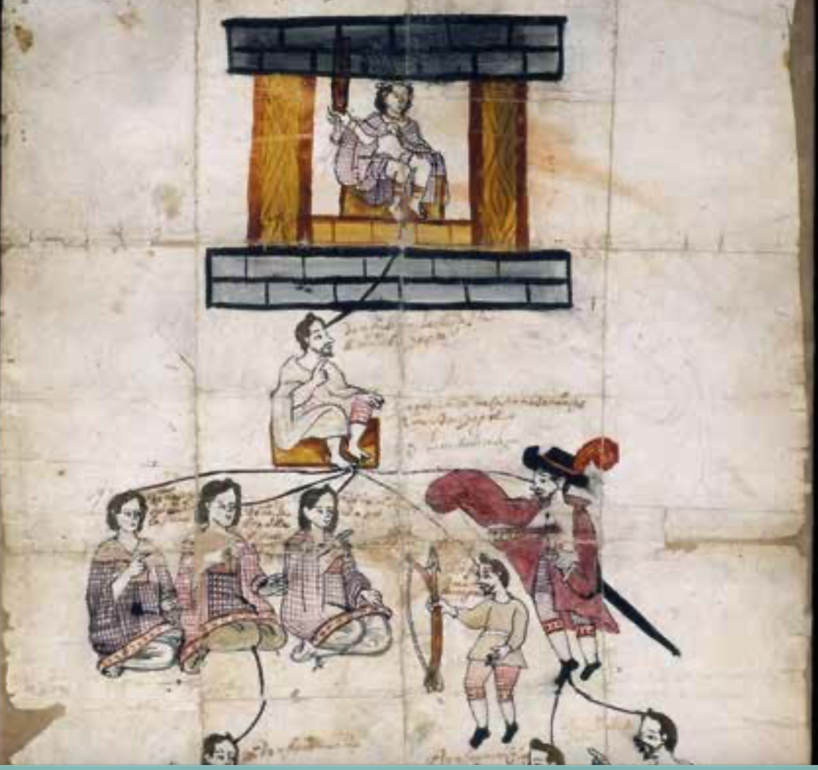
Lienzo Soler II
*
One of the most impressive objects I saw in the Humboldt Forum Museum is "Lienzo Seler II / Coixtlahuaca II," which is housed in a large display case. The approximately sixteen-square-meter map of the Coixtlahuaca territory, dates from the 16th century, so it is not a pre-conquest document. But, like pre-conquest maps, it records genealogical, geographical and topographic information.The early Spanish rulers of Mexico used such documents to help them adjudicate Indigenous claims to land possession and hereditary authority.
While the early Spanish conquerors were fascinated by the Nahuatl codices and libraries (amoxpialoyan), "their amazement and curiosity," writes Xavier Noguez, a professor of ancient Mexican history, "were eclipsed by their evangelizing zeal and their fear that the natives might continue to use these extraordinary compendia of knowledge." Diego de Landa, for example, burned all the Mayan books he found, "because there was naught in them but superstitions and falsehoods of the devil (superstición y falsedades del demonio), which made a powerful impression on them and caused them great sorrow. "Another culprit was Don Juan de Zumárraga, who collected hundreds of codices, piled them up in the marketplace at Tlatelolco, and burned them. All told, only fourteen or fifteen codices from before the Spanish conquest survive.
"We contemplate with indignation the cruelties inflicted by the early conquerors," Prescott wrote. "But indignation is qualified with contempt, when we see them thus ruthlessly trampling out the spark of knowledge, the common boon and property of all mankind. We may well doubt which has the strongest claims to civilization, the victor, or the vanquished."
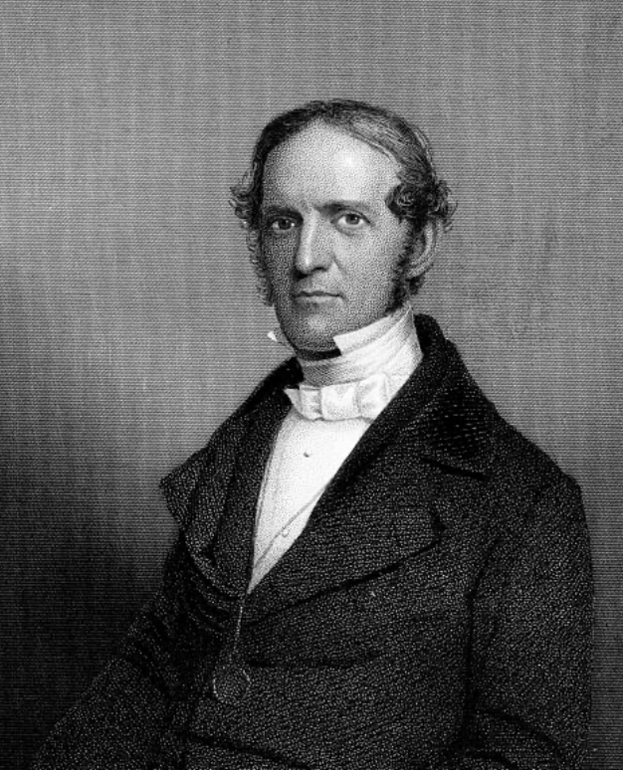
William H. Prescott
*
I could have spent all day at the Humboldt Forum Museum, but I had to meet my family for dinner that night. When I got back to the States, I resolved to learn more about Mesoamerican writing and the surviving codices, which are housed in several museums in Mexico and Europe.
My neighbor here in San Miguel, Rafael Franco, is something of an expert on the subject. A passionate book collector, Rafael owns a treasure trove of scholarly studies on the Mesoamerican codices, which he has generously made available to me. In his sunny and spacious studio, I have spent many mornings enthralled and enlightened by the books he has shared with me.
In the coming months, I am looking forward to writing more about my journey into Indigenous Mexican writing and literature. Despite the tragic loss of so many documents, there are still many treasures to explore and learn from. Once again, we are confronted with the incredible richness and sophistication of Mexico's long heritage.
**************

Philip Gambone, a retired high school English teacher, also taught creative and expository writing at Harvard for twenty-eight years. He is the author of five books, most recently As Far As I Can Tell: Finding My Father in World War II, which was named one of the Best Books of 2020 by the Boston Globe. It is available through Amazon, at the Biblioteca bookshop, and at Aurora Books off the Calzada de la Aurora.
**************
*****
Please contribute to Lokkal,
SMA's online collective:
 ***
***
Discover Lokkal:
Watch the two-minute video below.
Then, just below that, scroll down SMA's Community Wall.
Mission

Visit SMA's Social Network
Contact / Contactar

